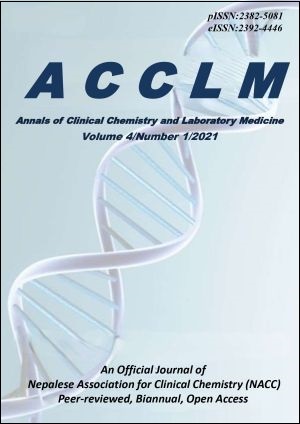Changing trends in antibiotic susceptibility pattern among clinical isolates of Pseudomonas species in a tertiary care hospital in Nepal
DOI:
https://doi.org/10.3126/acclm.v4i1.42674Keywords:
Antibiotic resistance, Pseudomonas sppAbstract
Background: Pseudomonas spp is notoriously known to be important agent of hospital as well as community acquired infections. These organisms are resistant to many antibiotics by intrinsic and acquired mechanisms making infections difficult to treat. Regular surveillance of infection and antibiotic resistance patterns is necessary for selection of appropriate antibiotics for treatment.
Methods: Non repeating Pseudomonas spp isolated from all clinical samples during the year 2017-2019 were included in the study. Identification of Isolates were done by standard conventional tests and antibiotics sensitivity test was done by Kirby-Bauer disk diffusion method following the CLSI guidelines, 2017.
Results: A total of 42,545 specimens comprising of sputum, blood, pus, urine, body fluids and endotracheal tubes were processed during the entire 3 year period. There was significant increase (p-value <0.05) in yearly isolation rate of Pseudomonas spp i.e. 141(7.95%), 197(12.14%) and 303(15.69%) isolates in the year 2017, 2018, and 2019 respectively. Resistance rates of the isolates to cefoparazone sulbactam, Piperacillin Tazobactam, and Tobramycin was significantly decreasing (p-value <0.05). Overall resistance to ceftazidime (66.13%) was alarming. Decrease in MDR isolates were statistically significant over 3 years e.g. 32(22.69%), 31(15.73%) and 37(12.21%) isolates in the year 2017, 2018 and 2019 respectively (p-value <0.05).
Conclusion: The rate of infection of Pseudomonas spp is significantly increasing. There was gradual decrease in number of resistant isolates and MDR isolates over the peri-od starting from 2017 to 2019 which is a favorable trend. The possible factors playing role have to be further studied, identified and promoted.
Downloads
Downloads
Published
How to Cite
Issue
Section
License
Copyright (c) 2021 Nepalese Association for Clinical Chemistry

This work is licensed under a Creative Commons Attribution-ShareAlike 4.0 International License.
Authors who publish with this journal agree to the following terms:
- The author transfers copyright to the Nepalese Association for Clinical Chemistry.
- The journal publishes the work under a Creative Commons Attribution License that allows others to share the work with an acknowledgement of the work's authorship and initial publication in this journal and under the same share-alike license used here.
- Authors are able to enter into separate, additional contractual arrangements for the non-exclusive distribution of the journal's published version of the work (e.g., post it to an institutional repository or publish it in a book), with an acknowledgement of its initial publication in this journal.
- Authors are permitted and encouraged to post their work online (e.g., in institutional repositories or on their website) prior to and during the submission process, as it can lead to productive exchanges, as well as earlier and greater citation of published work (See The Effect of Open Access).




